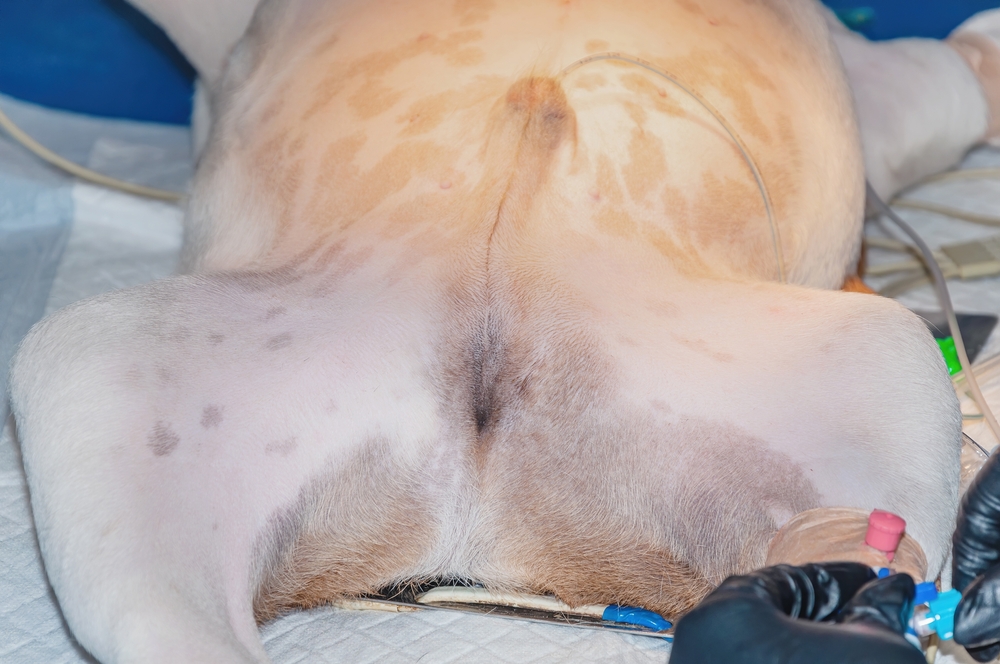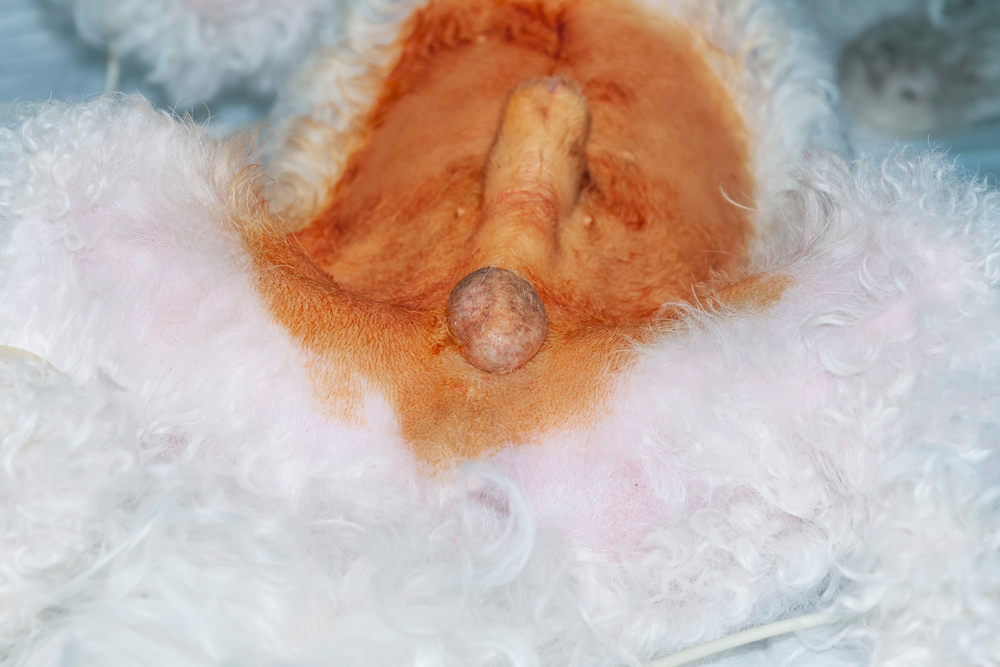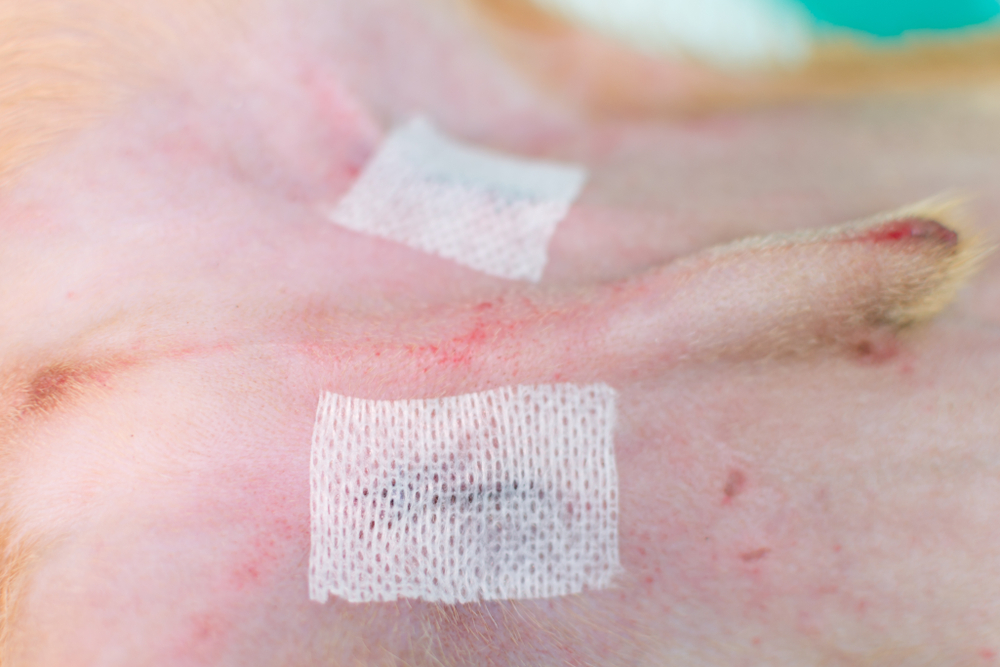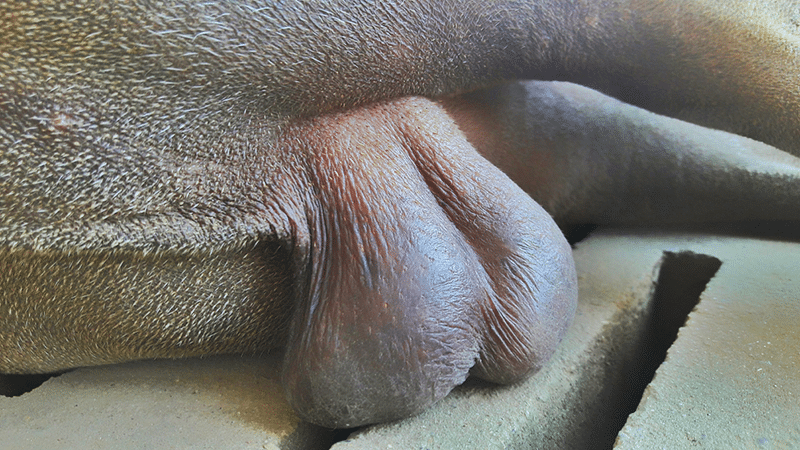If your dog only has one descended testicle, it could indicate a condition called cryptorchidism. The other testicle is likely retained in his abdomen or in the inguinal canal. Cryptorchidism can be problematic as it puts a dog at risk for developing a spermatic cord torsion or testicular cancer. Let’s learn more about what it means for a dog to only have one testicle and if it is a problem.

What Is Cryptorchidism?
Cryptorchidism, which literally means “hidden testicle”, is a condition where one or both testicles fail to descend into a dog’s scrotum.
Normally, testicles descend or “drop” into the scrotum by 6 to 16 weeks of age in puppies.1 The testes develop behind the kidneys in the abdomen while a puppy is still in the womb. Each testicle is attached to a ligament called the gubernaculum. The end of this ligament is attached to the scrotum. As the ligament shrinks, it pulls the testicle through the inguinal canal (the passage in the lower abdominal wall, located just above the groin) and into the scrotum. In cryptorchidism, one or both testicles are retained within a dog’s abdomen or inguinal canal.

What Causes a Dog to Develop Cryptorchidism?
Cryptorchidism is inherited. It is therefore important not to breed males with this condition. Although any breed of dog can have cryptorchidism, some breeds are at greater risk.
According to VCA Hospitals, the toy breeds, including Toy Poodles, Pomeranians, and Yorkshire Terriers, are more likely to have undescended testicles.2
What Are the Signs of Cryptorchidism?
Dogs with cryptorchidism usually don’t show any signs other than the presence of only one testicle in the scrotum or no testicles at all. The condition is not painful and does not make a dog feel sick unless complications arise.
Is your dog presenting any of these signs? We suggest you speak with a vet online.
💛 🐶 Speak To a Vet Online From the Comfort of Your Couch!

If you need to speak with a vet but can’t get to one, head over to PangoVet. It’s an online service where you can talk to a vet online and get the personalized advice you need for your pet — all at an affordable price!
What Complications Are Associated with Cryptorchidism?
There are two complications associated with cryptorchid testicles – spermatic cord torsion and testicular cancer.
In spermatic cord torsion, the spermatic cord, which provides blood flow to the testicle, becomes twisted. This twisting can cut off blood flow to the testicle, leading to severe pain and swelling. The only treatment is emergency surgery to neuter the dog. Fortunately, spermatic cord torsion is rare in dogs.
Older dogs with cryptorchidism are at risk of developing testicular cancer of the retained testicle. Cryptorchid dogs are estimated to be 13 times more likely to develop testicular cancer than normal dogs. Some dogs don’t show obvious signs of testicular cancer, but if they do, the signs depend on the type of cancer present.
Testicular tumors of the retained testicle are typically diagnosed post surgery when sections of the tumor are sent to the lab for histopathology, where a veterinary pathologist examines the tissue under a microscope. The best way to prevent testicular cancer from occurring in a cryptorchid dog. is to neuter the dog while it is still young.

Are Dogs with Cryptorchidism Sterile?
This depends on whether just one or both testicles are regained. The undescended testicle is not able to produce sperm due to the higher temperature inside the body. The retained testicle is also usually smaller than the scrotal testicle. If both testicles are retained, the dog will be sterile, while dogs with one cryptorchid testicle are still fertile with the testicle in the scrotum producing sperm.
What Is the Treatment for Cryptorchidism?
Castration (also known as neutering) is the only treatment for this condition. Castration involves surgically removing both testicles while the dog is under general anesthetic. In most cases of cryptorchidism, the retained testicle is located in the abdomen or the inguinal canal. It’s also possible for the testicle to be located under the skin in the groin area.
Cryptorchid dogs should be neutered early to avoid life-threatening conditions, such as testicular cancer and spermatic cord torsion, from developing.
What Is the Prognosis for Cryptorchidism?
The prognosis for cryptorchidism is excellent provided that the dog is neutered early before problems develop in the retained testicle.


Conclusion
If your dog only has one testicle, he probably has cryptorchidism, a condition where one or both testicles fail to descend into a dog’s scrotum. Cryptorchidism puts a dog at risk for developing spermatic cord torsion or testicular cancer. Dogs with this condition should therefore be neutered early to reduce the risk of problems occurring.
Featured Image Credit: Phatara, Shutterstock
